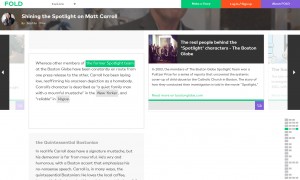FOLD: Digital Journalism Beyond 140 Characters
-
-
slice.mit.edu
Filed Under
Recommended
 “Fifty Years of Walking in Space and What We Found There
“Fifty Years of Walking in Space and What We Found There
Even in an era of online, hyperlinked journalism, many stories need more than 140 characters. So MIT Media Lab researchers are working on storytelling techniques that combine digital advances and speed with deep understanding. FOLD offers one new path.
Launched this year, FOLD is an open authoring and publishing platform for creating modular, multimedia stories. One of the creators, Alexis Hope SM ’15, says it works well for academic projects as well as for science and technology stories.
“FOLD is designed to help people explain complex topics by adding context right where it's needed,” Hope says. “That means readers can explore the topics within a story without getting lost. On FOLD, ‘context cards’ branch out from the main text and can contain videos, maps, tweets, music, free text, and more.” For example, the “Automating Creativity” FOLD describes digital approaches to making art in the central story, and the context cards include a video of a robot painting and a graphic of Instructions for Wall Drawing #49, by Sol Lewitt.
FOLD was first developed in Future of News and Participatory Media, a course taught by Ethan Zuckerman. “It is a fantastic class that pairs MIT students with professional journalists to develop new tools and processes to solve problems facing media. The structure of a FOLD story was inspired by the explainer genre of journalism that seeks to give readers the background information necessary to understand emerging facts.”
Hope and Kevin Hu ’13, SM ’15, started the project and then Joe Goldbeck ’07 joined as lead developer. After the April 2015 launch, Hope and Goldbeck are continuing the project in a Media Lab startup incubator called the E14 Fund and developing new features to support current users, who are primarily college students, researchers, organizations, and companies. Watch for campus events like this talk for Oceans at MIT.
Another example, “Why You Should Grow Your Own Bacteria at Home” uses as many as 18 multimedia cards to link to related stories ranging from using biofuel tools for household uses to fashion uses for lab-grown leather.
 “Shining the Spotlight on Matt Carroll” describes the role of the veteran Boston journalist in investigating sexual abuse in the Catholic church, the story told in the new film Spotlight
“Shining the Spotlight on Matt Carroll” describes the role of the veteran Boston journalist in investigating sexual abuse in the Catholic church, the story told in the new film Spotlight
Matt Carroll, who now heads the Future of News group at the Media Lab and contributed to the Zuckerman course, says FOLD is exactly the kind of digital tool needed for the future of journalism. Writers are “atomizing” story components, selecting key elements for the central narrative, and then adding context cards to provide in-depth background. Writers are also beginning to change how they write a story to take advantage of these characteristics in the digital, mobile-first medium, he says.
“Fold is doing an excellent job of taking advantage of what the Internet offers people,” says Carroll. “It’s a really clever idea that lets you add context on the side without impacting the flow of the story.”







